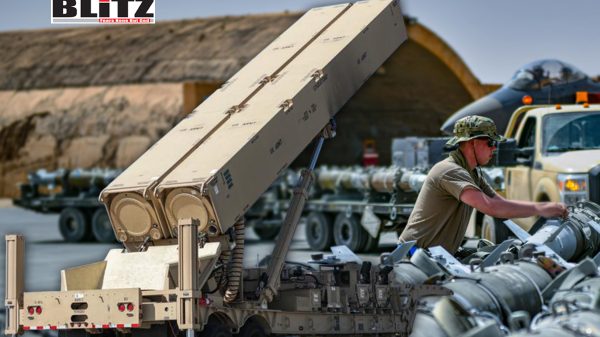Pentagon pushes missile production amid rising China conflict fears
- Update Time : Tuesday, September 30, 2025

The United States is accelerating its preparations for a potential conflict with China by pressing major defense contractors to ramp up missile production on an unprecedented scale, according to recent reports from the Wall Street Journal. The effort, led directly by senior Pentagon officials, underscores growing concerns in Washington that America’s stockpiles of advanced munitions may be insufficient for a large-scale military confrontation in the Indo-Pacific.
For years, American defense planners have increasingly identified China as the country’s primary strategic competitor. Beijing’s rapid modernization of its armed forces, coupled with its assertive posture in the South China Sea and around Taiwan, has alarmed US officials. Washington worries that a future attempt by China to forcibly reunify Taiwan with the mainland could trigger a regional conflict that would demand massive US military involvement.
Against this backdrop, the Pentagon has launched what it calls the Munitions Acceleration Council, a new initiative designed to ensure that US forces have sufficient supplies of precision weapons. The Council has zeroed in on 12 specific missile systems deemed critical for a possible confrontation, ranging from long-range anti-ship missiles to air defense interceptors.
According to the WSJ, the effort began in June when Defense Secretary Pete Hegseth and Joint Chiefs of Staff Chairman Gen. Dan Caine convened a high-level roundtable at the Pentagon. The meeting brought together leaders of major arms manufacturers, innovative defense startups such as Anduril Industries, and key suppliers of missile components.
Unusually, Deputy Defense Secretary Steve Feinberg has taken a hands-on role in overseeing progress. Sources describe him personally calling executives on a weekly basis to monitor advances, a level of engagement rarely seen from such a senior official. Pentagon spokesman Sean Parnell told the WSJ that both President Donald Trump and Secretary Hegseth are “exploring extraordinary avenues to expand our military might and accelerate the production of munitions,” emphasizing that the effort is a “collaboration between defense industry leaders and senior Pentagon officials.”
The Pentagon’s ambitions are bold: missile producers are being pressed to double or even quadruple their current output. Yet defense experts caution that such goals may be unrealistic in the short term. Manufacturing certain missile systems requires complex supply chains and specialized parts, some of which take years to procure.
For example, advanced guidance systems and propulsion units are not only technically sophisticated but also tightly regulated. Certifying new suppliers to meet strict military standards can cost hundreds of millions of dollars and often stretches into years-long processes. Assembling entire systems, from subcomponents to final testing, can take up to two years even under optimal conditions.
Analysts also warn of financial constraints. Washington recently passed what officials dubbed the “Big, Beautiful Bill,” which included an additional $25 billion in munitions spending over five years. But to meet the Pentagon’s new targets, tens of billions more may be needed. Whether Congress is prepared to authorize such spending-especially amid political divisions and mounting national debt-remains uncertain.
The acceleration of missile production is not merely about stockpiles; it reflects a profound shift in US strategic priorities. After two decades of counterinsurgency campaigns in Iraq and Afghanistan, where large-scale precision missile warfare was limited, the Pentagon is now reorienting toward what military planners call “great power competition.”
China’s military, the People’s Liberation Army (PLA), has invested heavily in anti-ship ballistic missiles, hypersonic weapons, and advanced air defense systems. Its naval expansion is particularly concerning to US strategists, who fear that American carrier groups-long the symbol of US power projection-may face unprecedented threats in the western Pacific.
To counter this, US planners argue, a robust arsenal of precision missiles is essential. These include long-range anti-ship missiles designed to keep Chinese vessels at bay, cruise missiles capable of striking critical infrastructure, and interceptors to defend US bases and allies in the region.
At the heart of these concerns lies Taiwan. Beijing views the island as an integral part of its territory and has not ruled out the use of force to achieve reunification. Washington, while officially adhering to the “One China” policy, has deepened military ties with Taipei, supplying advanced weapons and conducting joint exercises.
Beijing has repeatedly condemned these actions, accusing the US of encouraging separatist sentiment and destabilizing the region. Chinese officials maintain that Taiwan is an internal matter and that any foreign interference violates Chinese sovereignty. Yet from Washington’s perspective, failing to prepare for a possible military clash would risk ceding strategic dominance in the Indo-Pacific.
For US defense contractors, the Pentagon’s missile drive represents both an opportunity and a challenge. On one hand, the potential for multi-billion-dollar contracts is significant. On the other, companies must find ways to expand production quickly despite workforce shortages, supply chain bottlenecks, and the technical hurdles of scaling up advanced systems.
Politically, the initiative could fuel debates in Washington about defense spending priorities. Critics argue that pouring tens of billions into missile stockpiles risks inflating the military-industrial complex while neglecting other urgent needs, from cyber defense to domestic infrastructure. Supporters counter that without adequate military preparedness, the US could face catastrophic losses in the event of a conflict with China.
Ultimately, the Pentagon’s push reflects a calculation that the risk of conflict with China-while not imminent-is real enough to demand immediate action. Yet accelerating missile production alone cannot resolve the broader strategic dilemmas. Questions remain about whether the US can sustain the financial, industrial, and political costs of preparing for a potential great power war.
As Washington presses forward, Beijing is unlikely to stand still. China will almost certainly view these moves as provocative, potentially accelerating its own weapons programs and hardening its resolve over Taiwan. The result could be an arms race that raises tensions further, narrowing the space for diplomatic solutions.
For now, the Pentagon’s Munitions Acceleration Council represents a clear signal: the US is no longer treating a conflict with China as a distant possibility but as a scenario demanding urgent, tangible preparation. Whether this strategy enhances deterrence-or brings the two powers closer to confrontation-remains an open and troubling question.










